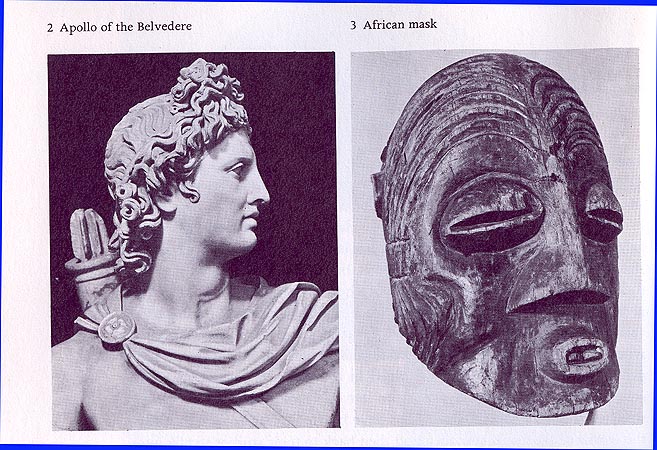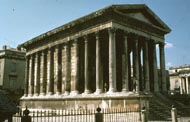ARTH
Home | ARTH
Courses | ARTH 200 | ARTH
200 Assignments
Excerpts from Sir Kenneth Clark,
Civilisation
"The Skin of Our Teeth"
The following excerpts are from a book
that accompanied the very popular PBS series that appeared during
the spring of 1969. I was a Freshman in college and was taking
my first Art History courses. I was enthralled by the series ,
and it was a contributing factor in my decision to become an Art
History major.
Looking back at the series from the
perspective of today, I am struck by the distance and the radical
changes in point of view. John Berger's television series appeared
only three years later. The criticisms that Berger addresses to
the Art Historical establishment are at least implicitly directed
to the perspectives offered in Clark's series. Berger would probably
label Sir Kenneth as a "high priest" of Art History.
Note this in relationship to the antipathy of Clark to religion
that comes out in the excerpts but is a recurring theme in the
series.
It is particularly interesting to see
the series and read these excerpts in relationship to John Berger's
discussion about history: "History always constitutes the
relation between a present and its past." Sir Kenneth believed
profoundly in the division between culture and politics. He believed
that culture presents a "higher truth" than that presented
by politics. But read these passages from the perspective of the
cultural and political contexts of the late 1960's: we were engaged
in the Vietnam War which was justified as defense of the "Free
World" from the expansion of Communism; the world lived under
the fear of nuclear annihilation; in June of 1967 there was an
Arab Israeli war; American cities through the late 1960's were
sites of racial unrest and violence; in the spring of 1968 there
was a student revolt in Paris just on the other side of the Seine
river from where Sir Kenneth is speaking; in the United States
student protest against the Vietnam war led to a violent clash
with the police and National Guard during the 1968 Democratic
National Convention in Chicago; and a youth, counter-culture manifested
in the popularity of Rock and Roll, the growth of a drug culture,
and widespread widespread advocation of "free love"
would have one of its defining moments during the summer of 1969
at Woodstock , New York. Read these passages with these events
in mind, and then think about John Berger's point "In the
end, the art of the past is being mystified because a privileged
minority is striving to invent a history which can retrospectively
justify the role of the ruling classes...." What do you make
of Clark's conception of "civilisation," and the role
of art in "civilisation"?
p. 1: I am standing on the Pont des Arts
in Paris. On the one side of the Seine is the harmonious, reasonable
facade of the Institute of France, built as a college in about
1670. On the other bank is the Louvre, built continuously from
the Middle Ages to the nineteenth century: classical architecture
at its most splendid and assured. Just visible upstream is the
Cathedral of Notre Dame --not perhaps the most lovable of cathedrals,
but the most rigorously intellectual facade in the whole of Gothic
art. The houses that line the banks of the river are also a humane
and reasonable solution of what town architecture should be, and
in front of them, under the trees, are the open bookstalls where
generations of students have found intellectual nourishment....
Across this bridge, for the last one hundred and fifty years,
students from the art schools of Paris have hurried to the Louvre
to study the works of art that it contains, and then back to their
studios to talk and dream of doing something worthy of the great
tradition. And on this bridge how many pilgrims from America,
from Henry James downwards, have paused and breathed in the aroma
of a long-established culture, and felt themselves to be at the
very centre of civilisation.
What is civilisation? I do not know. I
can't define it in abstract terms --yet. But I think I can recognise
it when I see it: and I am looking at it now. Ruskin said: "Great
nations write their autobiographies in three manuscripts, the
book of their deeds, the book of their words and the book of their
art. Not one of these books can be understood unless we read the
two others, but of the three the only trustworthy one is the last."
On the whole I think this is true. Writers and politicians may
come out with all sorts of edifying sentiments, but they are what
is known as declarations of intent. If I had to say which was
telling the truth about society, a speech by a Minister of Housing
or the actual buildings put up in his time, I should believe the
buildings.
But this doesn't mean that the history of civilisation
is the history of art --far from it. Great works of art can be produced in barbarous
societies --in fact the very narrowness of primitive society gives their ornamental
art a peculiar concentration and vitality. At some time in the ninth century
one could have looked down the Seine and seen the  prow
of a Viking ship coming up the river. Looked at today in the British Museum
it is a powerful work of art; but to the mother of a family trying to settle
down in her little hut, it / p. 2 would have seem less agreeable --as menacing
to her civilisation as the periscope of a nuclear submarine.
prow
of a Viking ship coming up the river. Looked at today in the British Museum
it is a powerful work of art; but to the mother of a family trying to settle
down in her little hut, it / p. 2 would have seem less agreeable --as menacing
to her civilisation as the periscope of a nuclear submarine.
An even more extreme example comes to
my mind, an African mask that belonged to Roger Fry. I remember
when he brought it and hung it up, and we agreed that it had all
the qualities of a great work of art. I fancy that most people
nowadays, would find it more moving than the head of the Apollo
of Belvedere. Yet for four hundred years after it was discovered
the Apollo was the most admired piece of sculpture in the world....

Whatever its merits as a work of art,
I don't think there is any doubt that the Apollo embodies a higher
state of civilisation than the mask. They both represent spirits,
messengers from another world --that is to say, from a world of
our own imagining. To the Negro imagination it is a world of fear
and darkness, ready to inflict horrible punishment for the smallest
infringement of a taboo. To the Hellenistic imagination it is
a world of light and confidence, in which the gods are like ourselves,
only more beautiful, and descend to earth in order to teach men
reason and the laws of harmony.
Fine words: and fine words butter no parsnips.
There was plenty of superstition and cruelty in the Greco-Roman
world. But, all the same, the /p.3 contrast between these images
means something. It means that at certain epochs man has felt
conscious of something about himself --body and spirit-- which
was outside the day-to-day struggle for existence and the night-to-night
struggle with fear; and he has felt the need to develop these
qualities of thought and feeling so that they might approach as
nearly as possible to an ideal of perfection --reason, justice,
physical beauty, all of them in equilibrium. He has managed to
satisfy this need in various ways --through myths, through dance
and song, through systems of philosophy and through the order
that he has imposed on the visible world. The children of his
imagination are also the expressions of an ideal.
Western Europe inherited such an ideal. It had been invented
in Greece in the fifth century before Christ and was without doubt the most
extraordinary creation in the whole of history, so complete, so convincing,
so satisfying to the mind and the eye, that it last practically unchanged for
over six hundred years. Of course, its art became stereotyped and conventional.
The same architectural language, the same imagery, the same theatres, the same
temples --at any time for five hundred years you could have found them all round
the Mediterranean, in Greece, Italy, France, Asia Minor, or North Africa. If
you had gone into the square of any Mediterranean town in the first century
you would hardly have known where you were, any more than you would in an airport
today. The so-called  Maison
Carrée at Nîmes is a little Greek temple that might have been anywhere
in the Graeco-Roman world.
Maison
Carrée at Nîmes is a little Greek temple that might have been anywhere
in the Graeco-Roman world.
Nîmes isn't very far
from the Mediterranean. Graeco-Roman civilisation stretched much further than
that --right up to the Rhine, right up to the borders of Scotland, although
by the time it got to Carlisle it had become a bit rough, like Victorian civilisation
on the North-West Frontier. It must have seemed absolutely indestructible. And
of course some of it was never destroyed. The so-called Pont du Gard, the aqueduct
not far from Nîmes, was materially beyond the destructive powers of the
barbarians. And a vast mass of fragments remained --the Museum at Arles is full
of them. "These fragments have I shored against my ruin." When the
spirit of man revived, they were there to be imitated by the masons who decorated
the local churches: but that was a long way off.
What happened? It took Gibbon six volumes to describe
the decline and fall of the Roman Empire, so I shan't embark on that. But thinking
about this almost incredible episode does tell one something about the nature
of civilisation. It shows that however complex and solid it seems, it is actually
quite fragile. It can be destroyed. What are its enemies? Well, first of all
fear --fear of war, fear of invasion, fear of plague and famine, that make it
/p. 4 simply not worthwhile constructing things, or planting trees or even panning
next year's crops. And fear of the supernatural, which means that you daren't
question anything or change anything. The late antique world was full of meaningless
rituals, mystery religions, that destroyed self-confidence....
Civilisation might have drifted downstream
for a long time, but in the middle of the seventh century there
appeared a new force, with faith, energy, a will to conquer and
an alternative culture: Islam. The strength of Islam was its simplicity.
The early Christian Church had dissipated its strength by theological
controversies, carried on for three centuries with incredible
violence and ingenuity. But Mahomet, the prophet of Islam, preached
the simplest doctrine that has ever gained acceptance; and it
gave to his followers the invincible solidarity that had once
directed the Roman legions. In a miraculously short --about fifty
years-- the classical world was overrun. Only its bleached bones
stood out against the Mediterranean sky.
The old source of civilisation was sealed
off, and if a new civilisation was to be born it would have to
face the Atlantic. What a hope! People sometimes tell me that
they prefer barbarism to civilisation. I doubt if they have given
it a long enough tiral. Like the people of Alexandria they are
bored by civilisation; but all the evidence suggests that the
boredom of barbarism is infinitely greater. Quite apart from discomforts
and privations, there was no escape from it. Very restricted company,
no books, no light after dark, no hope....
p. 31:....By the year 1000, the year in
which many timid people had feared that the world would come to
an end, the long dominance of the barbarian dominance was over,
and Western Europe was prepared for its first great age of civilisation.
ARTH Home | ARTH Courses
| ARTH 200 | ARTH
200 Assignments
 prow
of a Viking ship coming up the river. Looked at today in the British Museum
it is a powerful work of art; but to the mother of a family trying to settle
down in her little hut, it / p. 2 would have seem less agreeable --as menacing
to her civilisation as the periscope of a nuclear submarine.
prow
of a Viking ship coming up the river. Looked at today in the British Museum
it is a powerful work of art; but to the mother of a family trying to settle
down in her little hut, it / p. 2 would have seem less agreeable --as menacing
to her civilisation as the periscope of a nuclear submarine.
